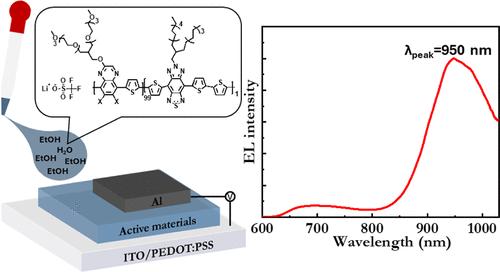可在发光电化学电池中从绿色溶剂中加工并提供950 nm发射的噻二唑苯并三唑基供体-受体三元聚合物
IF 7
2区 材料科学
Q2 CHEMISTRY, PHYSICAL
引用次数: 0
摘要
提供波长超过900纳米的发射的有机半导体可以实现广泛的应用,但不幸的事实是,只有少数这样的发射器被合成并在设备中展示了发射功能。本文通过设计和合成两种三元聚合物来解决这一问题,这两种三元聚合物包括低能隙噻吩-噻二唑苯并三唑(TBTzTD)供体-受体单元,作为少数客体结合在多数供体-受体共轭共聚物主体中,为噻吩-喹啉(TQ)或噻吩-二氟喹啉(TQ2F)。通过将支化的低聚乙二醇侧链接枝到喹啉单元上,这些三聚体在良性亲水性溶剂中具有高溶解度。通过在发光电化学电池(LECs)中的应用,证明了三元共聚物发射体的应用功能。值得注意的是,从可持续发展的角度来看,发射器是无金属的,单层LEC活性材料是由一种环保的水:乙醇溶剂混合物铸造而成的。从应用的角度来看,三聚体- lec器件具有在低电压下快速开启显着辐射的特点,并且它们以TQ-TBTzTD为发射器提供的峰值波长为935 nm,以TQ2F-TBTzTD为发射器提供的峰值波长为950 nm,这是有吸引力的。本文章由计算机程序翻译,如有差异,请以英文原文为准。

Thiadiazolobenzotriazole-Based Donor–Acceptor Terpolymers That Can Be Processed from Green Solvents and Deliver 950 nm Emission in Light-Emitting Electrochemical Cells
Organic semiconductors that deliver emission with a wavelength exceeding 900 nm can enable a wide range of applications, but the unfortunate fact is that only a small number of such emitters have been synthesized and have demonstrated emissive function in devices. Here, this issue is addressed through the design and synthesis of two terpolymers that comprise a low energy-gap thiophene-thiadiazolobenzotriazole (TBTzTD) donor–acceptor unit as the minority guest incorporated in a majority donor–acceptor conjugated copolymer host, being either thiophene-quinoxaline (TQ) or thiophene-difluoroquinoxaline (TQ2F). These terpolymers are further endowed with high solubility in benign hydrophilic solvents through the grafting of branched oligo(ethylene glycol) side chains onto the quinoxaline unit. The application function of the terpolymer emitters is demonstrated through their implementation in light-emitting electrochemical cells (LECs). It is notable from a sustainability perspective that the emitter is metal free and that the single-layer LEC active material is cast from an environmentally benign water:ethanol solvent blend. From an application perspective, it is attractive that the terpolymer-LEC devices feature a very fast turn-on to significant radiance at low voltage and that they deliver emission with a peak wavelength of 935 nm with TQ-TBTzTD as the emitter and 950 nm with TQ2F-TBTzTD as the emitter.
求助全文
通过发布文献求助,成功后即可免费获取论文全文。
去求助
来源期刊

Chemistry of Materials
工程技术-材料科学:综合
CiteScore
14.10
自引率
5.80%
发文量
929
审稿时长
1.5 months
期刊介绍:
The journal Chemistry of Materials focuses on publishing original research at the intersection of materials science and chemistry. The studies published in the journal involve chemistry as a prominent component and explore topics such as the design, synthesis, characterization, processing, understanding, and application of functional or potentially functional materials. The journal covers various areas of interest, including inorganic and organic solid-state chemistry, nanomaterials, biomaterials, thin films and polymers, and composite/hybrid materials. The journal particularly seeks papers that highlight the creation or development of innovative materials with novel optical, electrical, magnetic, catalytic, or mechanical properties. It is essential that manuscripts on these topics have a primary focus on the chemistry of materials and represent a significant advancement compared to prior research. Before external reviews are sought, submitted manuscripts undergo a review process by a minimum of two editors to ensure their appropriateness for the journal and the presence of sufficient evidence of a significant advance that will be of broad interest to the materials chemistry community.
 求助内容:
求助内容: 应助结果提醒方式:
应助结果提醒方式:


